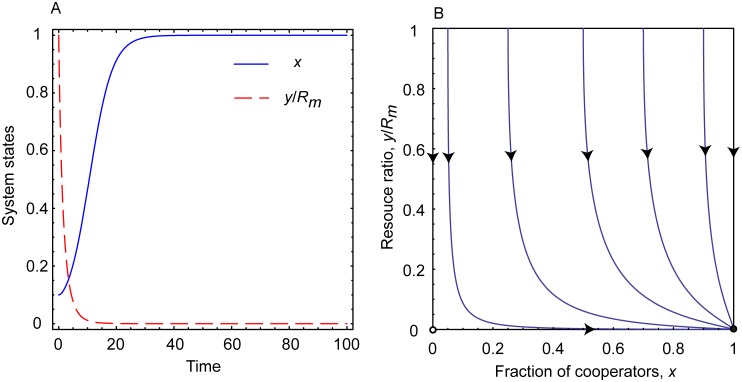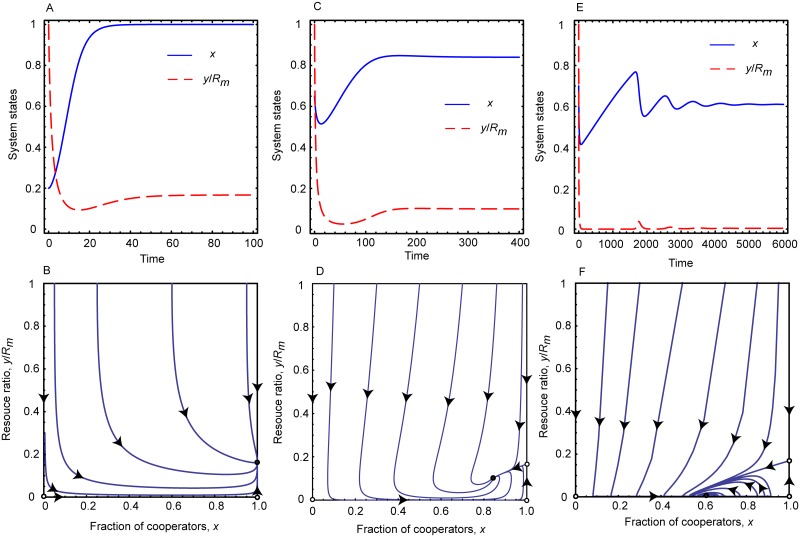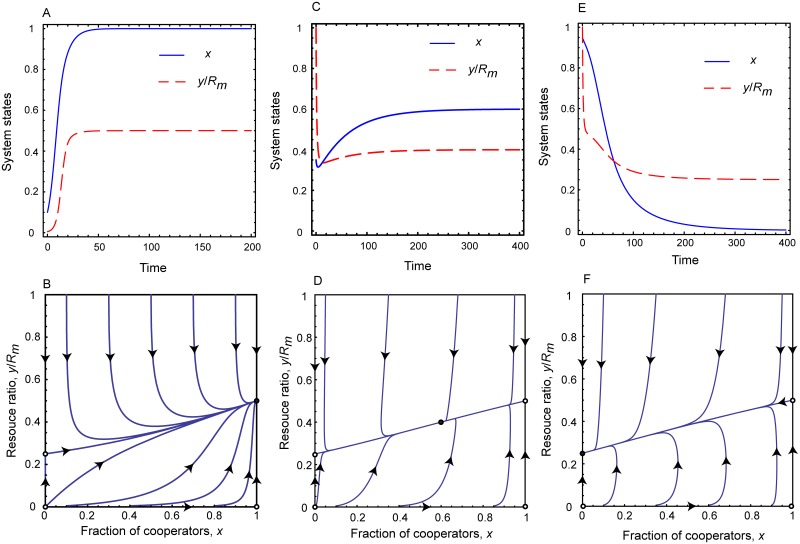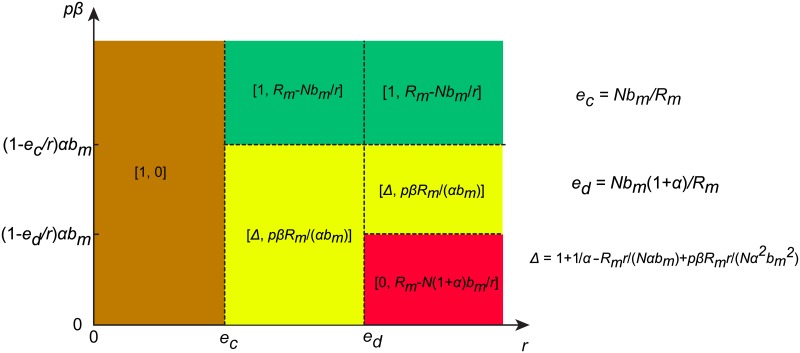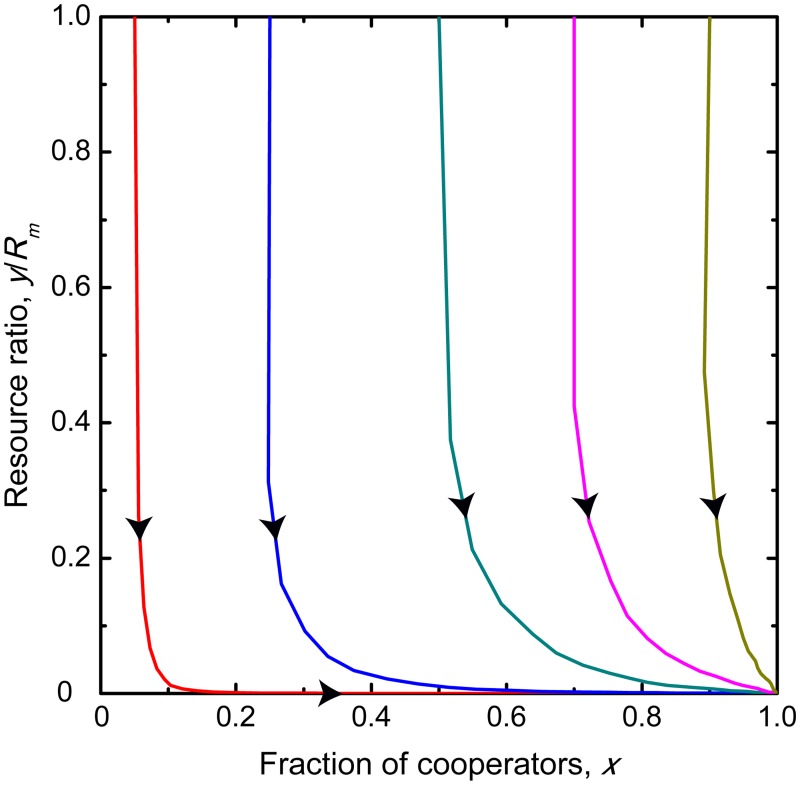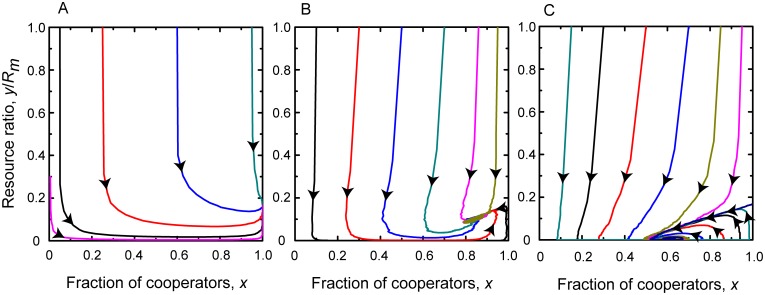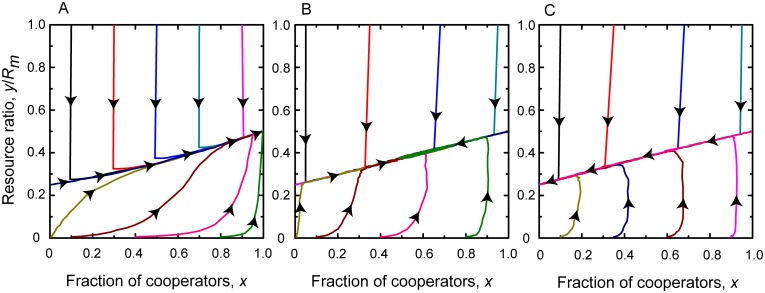Punishment and inspection for governing the commons in a feedback-evolving game (original) (raw)
Abstract
Utilizing common resources is always a dilemma for community members. While cooperator players restrain themselves and consider the proper state of resources, defectors demand more than their supposed share for a higher payoff. To avoid the tragedy of the common state, punishing the latter group seems to be an adequate reaction. This conclusion, however, is less straightforward when we acknowledge the fact that resources are finite and even a renewable resource has limited growing capacity. To clarify the possible consequences, we consider a coevolutionary model where beside the payoff-driven competition of cooperator and defector players the level of a renewable resource depends sensitively on the fraction of cooperators and the total consumption of all players. The applied feedback-evolving game reveals that beside a delicately adjusted punishment it is also fundamental that cooperators should pay special attention to the growing capacity of renewable resources. Otherwise, even the usage of tough punishment cannot save the community from an undesired end.
Author summary
Our proposed model considers not only the fundamental dilemma of individual and collective benefits but also focuses on their impacts on the environmental state. In general, there is a strong interdependence between individual actions and the actual shape of environment that can be described by means of a co-evolutionary model. Such approach recognizes the fact that even if our common-pool resources are partly renewable, they have limited growth capacities hence a depleted environment is unable to recover and reach a sustainable level again. This scenario would have a dramatic consequence on our whole society, therefore we should avoid it by punishing those who are not exercising restrain. We provide analytical and numerical evidences which highlight that punishment alone may not necessarily be a powerful tool to maintain a healthy shape of environment for the benefit of future generations. Cooperator actors, who are believed to take care of present state of our environment, should also consider carefully the growth capacity of renewable resources.
Introduction
Overexploitation of common-pool resources is a fundamental problem that can be identified in several seemingly different ecological systems [1, 2]. A well-known example is the danger of overfishing. Fishermen are motivated to catch the maximum amount of fish because restraint could only work if all others are behaving similarly. Otherwise, fish are driven to extinction which is the worst scenario for everyone [3, 4]. Similarly, we can continue this list endlessly by giving further examples, like overgrazing of common pasture lands, where individual short-term benefit seems to be in conflict with long-term interest of a larger population. The mutual feature of these cases is human activity influences the actual state of resources which has a negative feedback for not only those who degrade the environment but also for the whole community. We stress that this problem is not restricted to human-related activities, but may also appear at microscopic level including microbes, bacterias, and viruses [5–10], which explains why the problem of common-pool resource exploitation is an intensively studied research area of several disciplines [11–13].
It is a fundamental point that the sustainable use of common-pool resources is strongly based on the interdependence of resource and social dynamics [14]. On the one hand, the dynamics of resources, in particular renewable resources, are influenced by some ecological factors, such as the resource growth rate and the carrying capacity [14, 15]. On the other hand, these resources are also influenced by human behaviors on how to use them. Meanwhile, the shape of a dynamical resource also influences the prosperity of human well-being, which triggers frequency-dependent changes in individual strategies [16]. Thus, the interaction of resource dynamics and the evolution of individual-based behavior can be captured properly by a feedback-evolving game model where both variables are in the focus of governing equations [15–19].
A frequently recommend solution for sustaining the requested level of common-pool resource could be to punish defectors for over-harvesting [20–31]. In parallel, some other related control mechanisms, like ostracism or voluntary enforcement, are also discussed as viable solutions to the original problem [32, 33]. Importantly, the consequence of top-down regulation, which is based on inspection, permanent monitoring of agents and punishment, has been used for the forest commons management [34], but still begs for clarification especially in the presence of renewable resources.
Thus, in this work our principal interest is to explore how the application of punishment and inspection influences the competition of strategies when the benefit of given strategies depends sensitively on the actual state of environment. Furthermore, in our approach the common resource is considered as a dynamically renewable system which is also influenced by a feedback of individual strategies. This interdependence can be modeled by a co-evolutionary system where both strategies and environmental resources are subject to change. In our work, we depict this interdependent relationship by using the replicator equation for the evolution of strategies and the logistic growth model for the resource dynamics [35, 36], which provides a novel approach in the field of socio-ecological dynamics, to our knowledge. Indeed, some theoretical models have already raised the concept of environmental coupling [15, 16, 37, 38], but our present approach considers the growing capacity of a renewable resource explicitly. Additionally, punishment and permanent monitoring (inspection) are used as a control mechanism for blocking overexploitation of the common resource. We demonstrate that in addition to a delicately adjusted punishment regime, the growing capacity of renewable resource is fundamental for keeping resources at a sustainable level.
Materials and methods
We consider a population of individuals who all use a common resource at different levels. While the resource amount y in the common pool is limited, we assume that it is partly renewable and its dynamics can be described by the frequently used logistic population growth model [35, 36]. Accordingly, the dynamical change of the resource amount induced by its environment factor is given by y˙=ry(1-y/Rm), where r is the intrinsic growth rate and R m is the carrying capacity of resource pool. Furthermore, for the proper utilization of the resource, individuals are allocated an amount of resource from the common pool, which depends on the total resource amount y at a given time. According to the allocation rule, we suppose that the legal amount that each individual can be allocated from the pool is b l = b m y/R m, where b m is the maximal resource portion that each individual is allowed to use per unit of time when the amount of the common pool y reaches R m. Evidently, this individual limit portion satisfies b m ≤ R m/N, where N is the total number of individuals in the community.
For simplicity, we assume that individuals choose between two basically different strategies. The first group is called as cooperators or “law-abiding” individuals who follow the allocation rule and restrain their use to b l amount from the resource. The other group, called as defectors or “violators”, ignores the allocation rule and utilizes the common pool more intensively by getting a larger b v > b l amount. Here we suppose that b v = b l(1 + α), where α > 0 characterizes the severity of defection.
In order to avoid resource exploitation, we introduce a centrally organized inspection and punishing mechanism often used in realistic resource management systems [28, 34]. In particular, we assume that defection is detected with a probability p (0 < _p_ < 1), which is the probability of detecting a defector during a time unit. If an individual is identified for overexploiting common resources, then it will be punished with a fine _β_ (_β_ > 0) which is reduced from his collected payoff. In this way, the parameter p characterizes the effectiveness of monitoring system while the parameter β describes how severe the applied punishment is.
To explore the possible impact of inspection and punishment on the evolutionary process, we consider a well-mixed population and employ the replicator equation that describes the time evolution of competing strategies [35]. If we denote the fraction of cooperators by x then the governing equation is
where P L and P V are the payoffs of law-abiding individual (cooperator) and violator (defector) players, respectively. Notice that a player’s income is originated from the common-pool resource, although there is a coupling between individual payoff obtained from the feedback-evolving game and resource dynamics [15]. Thus, in our study for simplicity we assume that the related payoff values are directly written as P L = b l and P V = b v − pβ for cooperators and defectors, respectively.
In agreement with the co-evolutionary concept which considers the feedback of individual acts on the actual state of resource, the governing equation of common resource abundance can be extended as follows
| y˙=ry(1-y/Rm)-N[blx+(1-x)bv]. | (2) |
|---|
In the next section we analyze and discuss the possible equilibrium points of the above coupled equation system. Furthermore we extend our study by presenting the results of individual-based Monte Carlo simulations as a supplement to support the validity of our mathematical analysis for wider conditions.
Results
Equilibrium states of the feedback-evolving dynamical system
By substituting the payoff values into Eq 1, we have the following equation system
{x˙=x(1−x)(pβ−yRmbmα)y˙=ry(1−y/Rm)−NyRmbm[1+(1−x)α].
This equation system has at most five fixed points which are [x, _y_] = [0, 0], [0,Rm-bmN(1+α)r], [1, 0], [1,Rm-Nbmr], and [1+1α-RmrαbmN+pβRmrα2bm2N,pβRmbmα], respectively. Here the first four are boundary fixed points, while the last one is an interior fixed point. By calculating the first order partial derivaties [39], the Jacobian matrix of our system can be written as
J=[(1-2x)(pβ-αbmyRm)αbmx(x-1)RmαbmNyRmr-bmN(1+α-αx)+2ryRm].
The specific forms of this matrix at the above mentioned fixed points are respectively
J(0,0)=[pβ00r-bmN(1+α)Rm],
J(0,Rm-Nbm(1+a)r)=[pβ+αbm[(1+α)bmN-Rmr]Rmr0αbmN[Rmr-(1+α)bmN]Rmr(1+α)bmN-RmrRm],
J(1,Rm-Nbmr)=[αbm(Rmr-bmN)Rmr-pβ0αbmN(Rmr-bmN)RmrbmN-RmrRm],
and
J(1+1α-RmrαbmN+pβRmrα2bm2N,pβRmbmα)=[0(1α-RmrαbmN+pβRmrα2bm2N)[bm(1+α)Rm-rN+pβrαbmN]Npβ-pβrαbm].
The stability of these fixed points can be determined from the sign of the eigenvalues of the Jacobian [39]. It is easy to see that the eigenvalues of the matrices for the boundary fixed points are the corresponding diagonal elements. Hence, the stability of these fixed points depend exclusively on the signs of the diagonal elements of the related matrices. In addition, the trace of the last Jacobian is negative, hence the interior fix point has at least one negative eigenvalue. It also involves that the stability of the unique interior fixed point depends only on the sign of (1α-RmrαbmN+pβRmrα2bm2N)[bm(1+α)Rm-rN+pβrαbmN] term. For further analysis let us denote ec=bmNRm and ed=bmN(1+α)Rm respectively, representing the gain rates of cooperators and defectors in a population from the common resource. It also involves that we have 0 < e c ≤ 1 and e c < e d.
In the following, we distinguish three substantially different parameter regions where the distinction is based on the actual intrinsic growth rate value of the renewable common pool resource.
Slowly growing resource pool
First we consider the case when the resource pool is recovering slowly due to small intrinsic grow rate, which assumes that 0 < r < e c < e d. In this situation, we have rR m < b m N, and accordingly the system has only two fixed points in the parameter space of 0 ≤ x ≤ 1 and y ≥ 0. They are [0, 0] and [1, 0], respectively. Here the largest eigenvalue of J(0, 0) is positive, whereas the largest eigenvalue of J(1, 0) is negative due to the small value of r. Consequently, the fixed point [0, 0] is unstable, while the fixed point [1, 0] is stable. For the special case of r = e c, we find that one eigenvalue of the Jacobian matrix at the fixed point [1, 0] is zero and the other one is negative. In the SI text, we further provide the stability analysis of the fixed point by using the center manifold theorem [39].
A representative time evolution of the cooperation level and the abundance of common resource pool for 0 < r < e c < e d is plotted in Fig 1. It suggests that while the inspection and punishing mechanisms are capable to drive the system toward a full cooperator state, but this destination remains still unsatisfactory because the resource pool becomes fully depleted. This result warrants that it is not enough to be cooperator and consider only the actual shape of common resource pool. If the intrinsic growing rate of the latter is too low, then users should take a much lower share from the pool than it is believed naively based on the present status. Otherwise the common resource pool is unable to renew and the high cooperation level becomes useless.
Fig 1. Replicator dynamics for slowly growing resource.
Panel A: Time evolution of the fraction of cooperators and the resource abundance ratio. Panel B: Phase portrait on x − y/R m plane for r < e c < e d. Filled circle represents a stable fixed point, while open circle represents an unstable fixed point. For r < e c < e d the cooperation level is satisfactory in the final state, but resource abundance becomes depleted due to low growing resource rate. Parameters are r = 0.3, N = 1000, R m = 1000, p = 0.5, α = 0.5, β = 0.5, and b m = 0.5.
Moderately growing resource pool
If the intrinsic growth rate of resource pool is moderate, means 0 < _e_ _c_ < _r_ < _e_ _d_, then the conclusion is more subtle. In this situation, we have _b_ _m_ _N_ < _rR_ _m_ < _b_ _m_ _N_(1 + _α_) and 1+1α-RmrαbmN+pβRmrα2bm2N>0. In dependence of the efficiency of inspection and punishment we can distinguish two main cases. Note that the combined effect of these institutions can be characterized by the product of p and β parameters. The first case is when they are efficient hence their product exceeds pβ>bmα(1-ecr). In this case 1+1α-RmrαbmN+pβRmrα2bm2N>1 is also fulfilled. As a result, the system has three fixed points which are [0, 0], [1, 0], and [1,Rm-Nbmr], respectively. According to the sign of the largest eigenvalues [0, 0] and [1, 0] are unstable, while [1,Rm-Nbmr] is a stable fixed point. This result suggests that the system reaches an equilibrium point where all participants share the common pool cooperatively and the renewable resource is capable to maintain a sustainable level. This case is illustrated in the first column of Fig 2.
Fig 2. Replicator dynamics for moderately growing resource.
Top panels show the time evolution of the fraction of cooperators and the resource abundance ratio for different parameter values when e c < r < e d. Bottom panels show the related phase portraits on x − y/R m plane. Parameters for Panels A and B: r = 0.6, N = 1000, R m = 1000, p = 0.5, α = 0.5, β = 0.5, and b m = 0.5; for Panels C and D: r = 0.6, N = 1000, R m = 1000, p = 0.05, α = 0.5, β = 0.5, and b m = 0.5; for Panels E and F: r = 0.6, N = 1000, R m = 1000, p = 0.01, α = 0.5, β = 0.1, and b m = 0.5. These plots suggest that a sustainable state can be reached for appropriate inspection and punishment level, but the depleted environment state cannot be avoided if these institutions are ineffective.
When the inspection-punishment institutions are less effective, then the term bmα(1-ecr) exceeds pβ products. In this case 1+1α-RmrαbmN+pβRmrα2bm2N<1 and the system has four fixed points. They are [0, 0], [1, 0], [1,Rm-Nbmr], and [1+1α-RmrαbmN+pβRmrα2bm2N,pβRmbmα], respectively. Here only the last fixed point is stable while the first three are unstable. In equilibrium cooperators and defectors coexist at a finite resource abundance which is inversely proportional to α that characterizes how intensively defector players over exploit the common resource. The equilibrium resource level is linearly proportional to the pβ product, while the first part of the equilibrium fixed point contains a term which is free from pβ. This means that the stable fixed point drifts toward y = 0 axis faster than to the x = 0 axis as we weaken the impact of inspection-punishment institutions. Consequently, when the impact of inspection and punishment tends to zero-limit then the system still remains in a mixed state of cooperators and defectors but it has no particular importance because the environment becomes depleted. This is illustrated in the right column of Fig 2 where the stable fixed point approached the horizontal axis as we lower p that is the probability of successful detection of overexploitation.
In the special case when pβ=bmα(1-ecr), we find that there are three fixed points in the system, which are [0, 0], [1, 0], and [1,Rm-Nbmr], respectively. But one eigenvalue of the Jacobian matrix at the fixed point [1,Rm-Nbmr] is zero and the other one is negative. In the SI text, we provide the stability analysis of the fixed point by using the center manifold theorem [39]. Furthermore, we provide the theoretical analysis of the equilibrium points for the special case of r = e d.
Rapidly growing resource pool
Finally we discuss the case when the intrinsic growth rate of resource is large enough to exceed both the gain rate of cooperators e c and the gain rate of defectors e d. Here, we have rR m > b m N and rR m > b m N(1 + α). As previously, we can distinct two significantly different cases depending on the power of inspection and punishment institutions. If they are strong enough and the product of pβ exceeds bmα(1-ecr), then we have 1+1α-RmrαbmN+pβRmrα2bm2N>1. In this case the system has four fixed points which are [0, 0], [1, 0], [0,Rm-bmN(1+α)r], and [1,Rm-Nbmr], respectively. While the first three are unstable, the last one is a stable fixed point. This means that the system evolves into a full cooperator state where environmental resource stabilizes at a sustainable level. This level depends practically on the growth rate of resource. A representative phase portrait is plotted in the left column of Fig 3.
Fig 3. Replicator dynamics for rapidly growing resource.
Top panels show the time evolution of the fraction of cooperators and the resource abundance ratio for different parameter values when e c < e d < r. Bottom panels show the related phase portraits on x − y/R m plane. Parameters for Panels A and B: r = 1.0, N = 1000, R m = 1000, p = 0.5, α = 0.5, β = 0.5, and b m = 0.5; for Panels C and D: r = 1.0, N = 1000, R m = 1000, p = 0.2, α = 0.5, β = 0.5, and b m = 0.5; for Panels E and F: r = 1.0, N = 100, R m = 100, p = 0.1, α = 0.5, β = 0.5, and b m = 0.5. Due to the large intrinsic growth rate, the environmental resource will never be depleted. The strength of external institutions determines the relation of competing strategies in the equilibrium state.
If the above mentioned institutions are less powerful, then the product pβ cannot beat bmα(1-ecr) value. Hence we have 1+1α-RmrαbmN+pβRmrα2bm2N<1. Depending on the actual strength of inspection and punishment we can distinguish two subcases here. First, when the above mentioned institutions are still considerable, pβ exceeds bmα(1-edr) and the term 1+1α-RmrαbmN+pβRmrα2bm2N is positive. As a result, the system has five fixed points which are [0, 0], [0,Rm-bmN(1+α)r], [1, 0], [1,Rm-Nbmr], and [1+1α-RmrαbmN+pβRmrα2bm2N,pβRmbmα], respectively. Here only the last fixed point is stable while all the others are unstable. This scenario is illustrated in the middle column of Fig 3. From this result we can conclude that a reasonably strong external institution is capable to maintain the coexistence of cooperator and defectors states. Their fractions depend principally on the difference between resource usages of strategies which is characterized by the parameter α.
According to the second subcase, when the institutions are too weak and pβ product cannot exceed bmα(1-edr), the term 1+1α-RmrαbmN+pβRmrα2bm2N is negative. In this case the system has four fixed points which are [0,Rm-bmN(1+α)r], [0, 0], [1, 0], and [1,Rm-Nbmr], respectively. Here only the first fixed point is stable, while the rest are unstable. In this situation, which is illustrated in the right column of Fig 3, the evolution terminates into a full defection state. Still the latter is a sustainable state because the strong growing capacity of resource is capable to compensate to greediness of defector players.
Finally, we point out that there exist two special cases of αbm(1-ecr)=pβ and αbm(1-edr)=pβ for the rapidly growing resource pool situation. We provide the theoretical analysis for the equilibrium points in these two special cases in the SI text. In addition, in order to help readers to overview easily the evolutionary stable states of our feedback-evolving dynamical system for different parameter regions, we present an illustrative plot of the dynamical regimes in the parameter space (r, pβ), as shown in Fig 4. We use different colors to distinguish the qualitatively different solutions for different parameter values.
Fig 4. A representative plot of evolutionary outcomes on the phase plane.
Different colors are used to distinguish qualitatively different solutions in the parameter space (r, pβ). This plot highlights that the inner dynamical feature of renewable resource could be a decisive factor that can derogate the expected consequence of punishment.
Monte Carlo simulations
To support the robustness of the predictions made by our presented mathematical analysis, we perform Monte Carlo simulations [40–42] which may serve as an alternative approach to explore the possible coevolutionary dynamics. Indeed, in some cases this alternative approach, which contains stochastic elements and utilizes microscopic dynamics, goes beyond the limitations of macroscopic equations and provides alternative outcomes of evolutionary dynamics that are absent from a well-mixed behavior [41]. In the present case, however, this technique confirms our previous findings, and hence underlines the broader robustness of our observations.
In the Monte Carlo simulations, initially each individual in the population is chosen to violate or to follow the allocation rule. These strategies are denoted by s v = 0 and s l = 1 respectively. In agreement with the previous setup a law-abiding or cooperator player gets an amount y(t)b m/R m from resource which provides his payoff value. Here y(t) describes the actual state of resource pool at time step t. Alternatively, a defector who violates the allocation rule takes a larger amount y(t)b m/R m(1 + α) from the common resource pool. However, the whole population is inspected and defection is identified with a probability p. In this case the identified defector player is punished and a fine β is reduced from his payoff. Technically, it means that a defector collects a payoff P i = (1 + α)y(t)b m/R m − β with probability p, otherwise his final payoff is P i = (1 + α)y(t)b m/R m.
Because of the feedback mechanism the total amount of common resources is updated according to the rule
y(t+1)=y(t)+ry(t)[1-y(t)Rm]-∑iN[siy(t)bmRm+(1-si)y(t)bm(1+α)Rm],
where both the intrinsic growth of resource and the exploitation effect are considered.
According to the strategy evolution each individual i has a chance to imitate the strategy of another randomly chosen individual j. If P i < P j, then the strategy transfer occurs with the probability
where M ensures the proper normalization and is given by the maximum possible difference between the payoffs of i and j players [43].
Our results obtained at slow resource growth are summarized in Fig 5. This representative plot confirms our previous observations, namely, the effective inspection and punishment institutions are not enough to reach a sustainable state if the resource grow rate is too small. In this case the mentioned institutions are capable to shift the system toward a full cooperator state but it does not help because even law-abiding users are myopic and only consider the actual state of environment. As a conclusion, exploiting resource based on the present shape is harmful because common resource cannot recover this seemingly suitable usage.
Fig 5. Individual-based simulation for slowly growing resource.
Phase portraits in x − y/R M plane for different initial conditions when r < e c < e d. Simulation results show that the system converges to the [1, 0] state regardless of the initial conditions. Parameters: r = 0.3, p = 0.5, N = 1000, R m = 1000, α = 0.5, β = 0.5, and b m = 0.5.
When the intrinsic growth rate is higher, but moderate then we obtain qualitatively similar results to those obtained by analyzing the equation system. These observations are summarized in Fig 6. They suggest that in this case the application of inspection and punishment may result in the desired effect and a sustainable environmental state can be reached. But here the efficiency of applied top-down governance plays a decisive role in the final outcome.
Fig 6. Individual-based simulation for moderately growing resource.
Three representative phase portraits in x − y/R M plane using different initial conditions when e c < r < e d. Panels show results obtained at powerful (left), moderate (middle), and weak (right) external institutions. Depending on the effectiveness of inspection and punishment a sustainable state can be reached for the first two cases. The specific values are p = 0.5 and β = 0.5 in panel A; p = 0.05 and β = 0.5 in panel B; and p = 0.01 and β = 0.1 in panel C. Other parameters are r = 0.6, N = 1000, R m = 1000, α = 0.5, and b m = 0.5 for all cases.
Finally we summarize our observations in Fig 7 obtained for the rapidly growing resource case. These results are again in agreement with the prediction of equation system. More precisely, full D state, stable coexistence of C and D strategies, or full C state can also be obtained in dependence of the strength of inspection and punishment. The latter, however, have only second order importance because the fast recovery of environmental resource pool is capable to maintain a sustainable state for all cases.
Fig 7. Individual-based simulation for rapidly growing resource.
Three representative phase portraits in x − y/R M plane using different initial conditions when e c < e d < r. Panels show results obtained at powerful (left), moderate (middle), and weak (right) external institutions. Due to large growth rate a sustainable state can always be maintained. The strength of inspection and punishment determines only the level of this state. The specific values are p = 0.5, 0.2, and 0.1 for panel A, B, and C, respectively. Other parameters are r = 1.0, N = 1000, R m = 1000, α = 0.5, β = 0.5, and b m = 0.5 for all cases.
Discussion
The surprising efficiency of evolutionary game theory in understanding our complex world in widely different scales makes possible to predict the long-term consequences of individual actions on resource management [44, 45]. Our principal aim is to develop a realistic model where there is a coupling between the behavior of players and the developing state of a common pool resource. More precisely, we consider not just exploitation of the resource but also take account into the fact that the environmental common pool can be renewable. The latter may be captured by a single parameter which characterizes the intrinsic growth rate of the resource.
In this more realistic model of a coupled social-resource system, we further introduce a top-down-like control mechanism that serves to block overexploitation of the common resource. This control mechanism is not only motivated by theoretical works or lab experiments [20, 33, 46], but is also stimulated by realistic field investigations focusing on the forest commons management [34, 47]. In contrast to a bottom-up self-regulation this top-down-type control assumes an effective external monitoring of agents. We have then shown that overexploitation is not the only danger of a sustainable state. In particular, it is not enough to restrict our share to a limit that is estimated from the actual abundance of the common resource, but we should also consider simultaneously the growing capacity of the latter. For example, if the growth rate is too small then even strong inspection and punishment are unable to prevent us from a depleted resource. Taking the other extreme, if the growth rate is high enough then the mentioned institutions have role only in how high resource level is stabilized, but we can always keep a sustainable state. As we pointed out monitoring overexploitation and punishing it has critical role at an intermediate growth rate of environmental resource, when efficient institutions can reverse the final destination of evolutionary process.
Renewable resources are generally believed to play key roles in achieving a sustainable human development [48]. Indeed, they are essential but we must consider not only temporal changes in environmental conditions but also their intrinsic features when designing their sustainable usage [33]. Otherwise our additional efforts to control participants become useless. Conceptually similar conclusion can also be obtained when ostracism is introduced as a collective control mechanisms into another coupled social-resource model proposed by Tavoni et al. [15]. It is found that the stationary state of cooperators and defectors does not only depend on the ostracism strength, but also on the resource inflow [33]. We thus conclude that when we design a social control mechanism to solve the overexploitation problem in a coupled social-resource system we should first pay attention to the intrinsic features of the system which can determine in advance whether the designed control mechanism is capable to drive the level of common resource toward the desired direction.
Finally, we note that our model of dynamical cooperation and renewable environmental resource uses several simplifying assumptions and is just a first step toward a more sophisticated coevolutionary model. Still, we strongly believe that our results could be helpful to understand the role of growing capacity of renewable resources in designing control mechanism of punishment for governing the commons.
On the other hand, we may consider to relax or extend these simplifying assumptions for future research in order to understand better the coevolutionary dynamics of renewable resources and human cooperation in specific conditions. More precisely, in the present work we have considered that individual payoff in the replicator equation is identified as individual income originated directly from the common-pool resource. Indeed, there should exist a transformation relationship between individual income and payoff, which can be reflected by the production function [15]. Thus incorporating such production function into our current model could be a further step toward a more realistic description. Meanwhile it is also interesting to study whether such transformation relationship can influence the evolutionary outcome in the coevolutionary framework we proposed. Second, as pointed out in Ref. [16] there exists a relative speed by which human behaviors modify the resource state, which was not considered in the framework of present model. Hence, a possible extension of our work could be to consider the relative changing speed between the resource dynamics and the cooperation level in the population. Third, we have considered a well-mixed interaction between agents where the environmental feedback was valid globally. Evidently, one may consider a structured population where both interactions and feedback from environment act locally, hence opening a new research path toward more realistic situations.
Supporting information
S1 Text. Supporting information for: Punishment and inspection for governing the commons in a feedback-evolving game.
(PDF)
Data Availability
All relevant data are within the paper and its Supporting Information files.
Funding Statement
This research was supported by the National Natural Science Foundation of China (Grant No. 61503062) and the Hungarian National Research Fund (Grant K-120785). The funders had no role in study design, data collection and analysis, decision to publish, or preparation of the manuscript.
References
- 1.Ostrom E. Governing the commons: The Evolution of Institutions for Collective Action. Cambridge, U.K: Cambridge University Press; 1990. [Google Scholar]
- 2.Hardin G. The Tragedy of the Commons. Science. 1968; 162:1243–1248. 10.1126/science.162.3859.1243 [DOI] [PubMed] [Google Scholar]
- 3.Pauly D, Christensen V, Guénette S, Pitcher TJ, Sumaila UR, Walters CJ, et al. Towards sustainability in world fisheries. Nature. 2002; 418:689–695. 10.1038/nature01017 [DOI] [PubMed] [Google Scholar]
- 4.Kraak SBM. Exploring the ‘public goods game’ model to overcome the tragedy of the commons in fisheries management. Fish and Fisheries. 2011; 12:18–33. 10.1111/j.1467-2979.2010.00372.x [DOI] [Google Scholar]
- 5.Crespi BJ. The evolution of social behavior in microorganisms. Trends Ecol Evol. 2001; 16:178–183. 10.1016/S0169-5347(01)02327-8 [DOI] [PubMed] [Google Scholar]
- 6.Hummert S, Hummert C, Schröter A, Hube B, Schuster S. Game theoretical modelling of survival strategies of Candida albicans inside macrophages. J Theor Biol. 2010; 264:312–318. 10.1016/j.jtbi.2010.01.022 [DOI] [PubMed] [Google Scholar]
- 7.West SA, Buckling A. Cooperation, virulence and siderophore production in bacterial parasites. Proc R Soc Lond B. 2003; 270:37–44. 10.1098/rspb.2002.2209 [DOI] [PMC free article] [PubMed] [Google Scholar]
- 8.Rankin DJ, Bargum K, Kokko H. The tragedy of the commons in evolutionary biology. Trends Ecol Evol. 2007; 22:643–651. 10.1016/j.tree.2007.07.009 [DOI] [PubMed] [Google Scholar]
- 9.Gore J, Youk H, van Oudenaarden A. Snowdrift game dynamics and facultative cheating in yeast. Nature. 2009; 459:253–256. 10.1038/nature07921 [DOI] [PMC free article] [PubMed] [Google Scholar]
- 10.Schuster S, de Figueiredo LF, Schroeter A, Kaleta C. Combining Metabolic Pathway Analysis with Evolutionary Game Theory. Explaining the occurrence of low-yield pathways by an analytic optimization approach. BioSystems. 2011; 105:147–153. 10.1016/j.biosystems.2011.05.007 [DOI] [PubMed] [Google Scholar]
- 11.Cox M, Arnold G, Tomás SV. A Review of Design Principles for Community-based Natural Resource Management. Ecol Soc. 2012; 15:38 10.5751/ES-03704-150438 [DOI] [Google Scholar]
- 12.Hauser OP, Rand DG, Peysakhovich A, Nowak MA. Cooperating with the future. Nature. 2014; 511:220–223. 10.1038/nature13530 [DOI] [PubMed] [Google Scholar]
- 13.Sugiarto HS, Lansing JS, Chung NN, Lai CH, Cheong SA, Chew LY. Social Cooperation and Disharmony in Communities Mediated through Common Pool Resource Exploitation. Phys Rev Lett. 2017; 118:208301 10.1103/PhysRevLett.118.208301 [DOI] [PubMed] [Google Scholar]
- 14.Brander J, Taylor MS. The simple economics of easter island: A Ricardo-Malthus model of renewable resource use. Am Econ Rev. 1998; 88:119–138. [Google Scholar]
- 15.Tavoni A, Schlüter M, Levin S. The survival of the conformist: Social pressure and renewable resource management. J Theor Biol. 2012; 299:152–161. 10.1016/j.jtbi.2011.07.003 [DOI] [PubMed] [Google Scholar]
- 16.Weitz JS, Eksin C, Paarporn K, Brown SP, Ratcliff WC. An oscillating tragedy of the commons in replicator dynamics with game-environment feedback. Proc Natl Acad Sci USA. 2017; 113:E7518–E7525. 10.1073/pnas.1604096113 [DOI] [PMC free article] [PubMed] [Google Scholar]
- 17.Lade SJ, Tavoni A, Levin SA. Regime shifts in a social ecological system. Theor. Ecol. 2013; 6:359–372. 10.1007/s12080-013-0187-3 [DOI] [Google Scholar]
- 18.Schlüter M, Tavoni A, Levin S. Robustness of norm-driven cooperation in the commons. Proc R Soc Lond B. 2016; 283: 20152431 10.1098/rspb.2015.2431 [DOI] [PMC free article] [PubMed] [Google Scholar]
- 19.Lee JH, Jusup M, Iwasa Y. Games of corruption in preventing the overuse of common-pool resources. J Theor Biol. 2017; 428:76–86. 10.1016/j.jtbi.2017.06.001 [DOI] [PubMed] [Google Scholar]
- 20.Fehr E, Gächter S. Cooperation and Punishment in Public Goods Experiments. Am Econ Rev. 2000; 90:980–994. 10.1257/aer.90.4.980 [DOI] [Google Scholar]
- 21.Henrich J. Cooperation, Punishment, and the Evolution of Human Institutions. Science. 2006; 312:60–61. 10.1126/science.1126398 [DOI] [PubMed] [Google Scholar]
- 22.Gächter S, Renner E, Sefton M. The long-run benefits of punishment. Science. 2008; 687:1510. [DOI] [PubMed] [Google Scholar]
- 23.Sigmund K, De Silva H, Traulsen A, Hauert C. Social learning promotes institutions for governing the commons. Nature. 2010; 466:861–863. 10.1038/nature09203 [DOI] [PubMed] [Google Scholar]
- 24.Vasconcelos VV, Santos FC, Pacheco JM. A bottom-up institutional approach to cooperative governance of risky commons. Nat Clim Change. 2013; 3:797–801. 10.1038/nclimate1927 [DOI] [Google Scholar]
- 25.Pacheco JM, Vasconcelos VV, Santos FC. Climate change goverance, cooperation and self-organization. Phys Life Rev. 2014; 11:573–586. 10.1016/j.plrev.2014.02.003 [DOI] [PubMed] [Google Scholar]
- 26.Johnson S. Escaping the tragedy of the commons through targeted punishment. R Soc Open Sci. 2015; 2:150223 10.1098/rsos.150223 [DOI] [PMC free article] [PubMed] [Google Scholar]
- 27.Chen X, Sasaki T, Brännström Å, Dieckmann U. First carrot, then stick: how the adaptive hybridization of incentives promotes cooperation. J R Soc Interface. 2015; 12:20140935 10.1098/rsif.2014.0935 [DOI] [PMC free article] [PubMed] [Google Scholar]
- 28.Chen X, Sasaki T, Perc M. Evolution of public cooperation in a monitored society with implicated punishment and within-group enforcement. Sci Rep. 2015; 5:17050 10.1038/srep17050 [DOI] [PMC free article] [PubMed] [Google Scholar]
- 29.Okada I, Yamamoto H, Toriumi F, Sasaki T. The effect of incentives and meta-incentives on the evolution of cooperation. PLOS Comp Biol. 2015; 11:e1004232 10.1371/journal.pcbi.1004232 [DOI] [PMC free article] [PubMed] [Google Scholar]
- 30.Perc M, Jordan JJ, Rand DG, Wang Z, Boccaletti S, Szolnoki A. Statistical physics of human cooperation. Phys Rep. 2017; 687:1–51. 10.1016/j.physrep.2017.05.004 [DOI] [Google Scholar]
- 31.Wang Q, He N, Chen X. Replicator dynamics for public goods game with resource allocation in large populations. Appl. Math. Comput. 2018; 328: 162–170. [Google Scholar]
- 32.Nakamaru M, Yokoyama A. The Effect of Ostracism and Optional Participation on the Evolution of Cooperation in the Voluntary Public Goods Game. PLoS ONE. 2014; 9:e108423 10.1371/journal.pone.0108423 [DOI] [PMC free article] [PubMed] [Google Scholar]
- 33.Sugiarto HS, Chung NN, Lai CH, Cheong SA, Chew LY. Emergence of cooperation in a coupled socio-ecological system through a direct or an indirect social control mechanism. J Phys Commun. 2017; 1:055019 10.1088/2399-6528/aa9b0e [DOI] [Google Scholar]
- 34.Yang W, Liu W, Viña A, Tuanmu MN, He G, Dietz T, et al. Nonlinear effects of group size on collective action and resource outcomes. Proc Natl Acad Sci USA. 2013; 110:10916–10921. 10.1073/pnas.1301733110 [DOI] [PMC free article] [PubMed] [Google Scholar]
- 35.Hofbauer J, Sigmund K. Evolutionary Games and Population Dynamics. Cambridge, U.K: Cambridge University Press; 1998. [Google Scholar]
- 36.Tsoularis A, Wallace J. Analysis of logistic growth models. Math Biosci. 2002; 179:21–55. 10.1016/S0025-5564(02)00096-2 [DOI] [PubMed] [Google Scholar]
- 37.Chen X, Perc M. Excessive abundance of common resources deters social responsibility. Sci Rep. 2014; 4:4161 10.1038/srep04161 [DOI] [PMC free article] [PubMed] [Google Scholar]
- 38.Brandt G, Merico A, Vollan B, Schlüter A. Human Adaptive Behavior in Common Pool Resource Systems. PLoS ONE. 2012; 7:e52763 10.1371/journal.pone.0052763 [DOI] [PMC free article] [PubMed] [Google Scholar]
- 39.Khalil HK. Nonlinear Systems. Prentice Hall, NJ; 1996. [Google Scholar]
- 40.Maciejewshi W, Fu F, Hauert C. Evolutionary game dynamics in populations with heterogeneous structures. PLOS Comp Biol. 2014; 10: e1003567 10.1371/journal.pcbi.1003567 [DOI] [PMC free article] [PubMed] [Google Scholar]
- 41.Adami C, Schossau J, Hintze A. Evolutionary game theory using agent-based methods. Phys Life Rev. 2016; 19:1–26. 10.1016/j.plrev.2016.08.015 [DOI] [PubMed] [Google Scholar]
- 42.Wu T, Wang L, Fu F. Coevolutionary dynamics of phenotypic diversity and contingent cooperation. PLOS Comp Biol. 2017; 13: e1005363 10.1371/journal.pcbi.1005363 [DOI] [PMC free article] [PubMed] [Google Scholar]
- 43.Santos FC, Santos MD, Pacheco JM. Social diversity promotes the emergence of cooperation in public goods games. Nature. 2008; 454:213–216. 10.1038/nature06940 [DOI] [PubMed] [Google Scholar]
- 44.Tavoni A. Game theory: Building up cooperation. Nat Clim Change. 2013; 3:782–783. 10.1038/nclimate1962 [DOI] [Google Scholar]
- 45.Szolnoki A. The power of games: Comment on “Climate change governance, cooperation and self-organization” by Pacheco, Vasconcelos and Santos. Phys Life Rev. 2014; 11:589–590. 10.1016/j.plrev.2014.04.006 [DOI] [PubMed] [Google Scholar]
- 46.Sasaki T, Brännström A, Dieckmann U, Sigmund K. The take-it-or-leave-it option allows small penalties to overcome social dilemmas. Proc Natl Acad Sci USA. 2012; 109:1165–1169. 10.1073/pnas.1115219109 [DOI] [PMC free article] [PubMed] [Google Scholar]
- 47.Rustagi D, Engel S, Kosfeld M. Conditional cooperation and costly monitoring explain sucess in forest commons management. Science. 2010; 330:961–965. 10.1126/science.1193649 [DOI] [PubMed] [Google Scholar]
- 48.Valente S. Sustainable Development, Renewable Resources and Technological Progress. Env Res Econ. 2005; 30:115–125. 10.1007/s10640-004-2377-3 [DOI] [Google Scholar]
Associated Data
This section collects any data citations, data availability statements, or supplementary materials included in this article.
Supplementary Materials
S1 Text. Supporting information for: Punishment and inspection for governing the commons in a feedback-evolving game.
(PDF)
Data Availability Statement
All relevant data are within the paper and its Supporting Information files.
